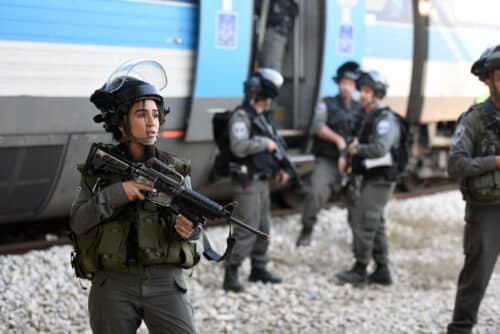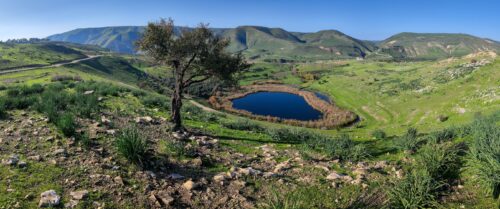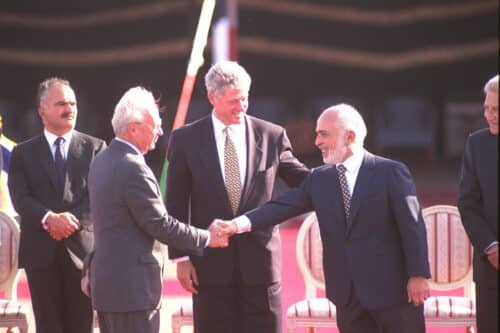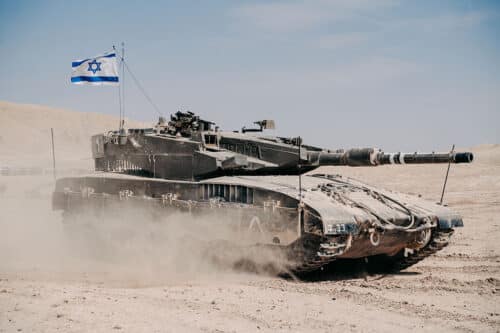The Jordan Valley has held great historical, religious and security-related importance in the Jewish tradition throughout the ages. Historical events that are intertwined all around the Jordan Valley in its broadest sense have greatly shaped the land and have had significant ramifications for the Jewish People that still affect Israeli society to this day.
There is broad consensus among most Zionist leaders, statesmen, public figures and generals of the State of Israel regarding the clear urgency to possess and control this area, including the long stretch of land that constitutes the natural eastern border of the State of Israel and dominates the eastern gateways to Jerusalem, the heart of the country.
Despite the widespread recognition and broad consensus on this matter, displayed by pioneers who settled in the area, no Israeli government has ever mustered the courage to declare full sovereignty over the Jordan Valley to the people of the world. On March 15, 2023, the coalition voted against MK Avigdor Liberman’s bill calling for the declaration of sovereignty over the Jordan Valley. We should now be asking whether Israel’s 37th government has plans to declare sovereignty over the Jordan Valley during its term? Is the time still not yet ripe for such a declaration, even after more than 3,300 years of history, 75 years of independence, 55 years of control and settlement along the entire length of the valley, and 18 similar bills that have repeatedly been rejected one after another since the 18th Knesset?
From the Time of Old, and Until the Establishment of the State of Israel
The special affinity of the People of Israel and the Jordan Valley commenced when the Israelites crossed over the Jordan River and entered the Land of Israel on the 10th of Nissan, 2488 (equivalent to 1273 BCE) according to the Book of Joshua, Chapter 4, Verse 19: “And the people came up out of the Jordan on the tenth day of the first month, and encamped in Gilgal, in the east border of Jericho.” This historical event, which takes place following the exodus from Egypt, and at the end of forty years of wandering in the desert, is celebrated nowadays as Yom Ha’Aliyah (Aliyah Day), which has been added to the official calendar of the State of Israel on the 7th of Cheshvan.
Yom Ha’Aliya was established by law as a national holiday of the State of Israel, and approved by the Knesset on June 21, 2016, in recognition of the importance of immigration to Israel as the basis for the existence, development and shaping of the State of Israel, as a multicultural society, and to commemorate the day the Israelites crossed over from the desert into the Land of Israel on the 10th of Nissan. It is worth noting that the 7th of Cheshvan was chosen to commemorate Aliyah Day also because it’s proximity to Parashat Lech L’cha, the Torah portion during which Abraham is commanded to immigrate to and ‘inherit’ the Land of Israel. As was written in Genesis, Chapter 12, Verses 6-7: “And Abram passed through the land, until the place of Shechem, until the plain of Moreh, and the Canaanites were then in the land. And the Lord appeared to Abram, and He said, ‘To your seed I will give this land,’ and there he built an altar to the Lord, Who had appeared to him.”
We can learn about the strategic importance of the Jordan Valley for the security and control over the Land of Israel in modern times from battles in the region between the British forces, under the command of General Allenby, and the retreating Turkish Ottoman forces, which took place 105 years ago, at the start of the 20th century. In August 1918, Ze’ev Jabotinsky served as a young officer in the 38th Battalion (aka The Jewish Legion) led by Colonel John Patterson in an effort to protect Wadi Malha and Um A-Shurt, near current-day Gilgal and Netiv Hagdud.
The battalion’s mission was to prevent the Ottoman forces from regrouping and crossing the Jordan River to the west. The 39th Battalion, led by Lt. Col. Eliezer Margolin, which had been preparing for the protection of the Wadi Uja region, joined the 38th Battalion on September 15, the Eve of Yom Kippur. Over the next few nights, these two Jewish battalions fought against the enemy, and were responsible for assisting British forces under the command of Maj. Gen. Edward Chaytor to force their way through to the east all the way to Amman, at which point the Ottoman forces surrendered.
At the San Remo Conference, a meeting of post-World War I allied countries held in April 1920 (103 years ago), territories from the Ottoman Empire were divided up between the European powers. The conference reaffirmed and expanded upon the terms of the Sykes-Picot Agreement, which had been signed on May 16, 1916, between France and Great Britain regarding the partition of regional territories between them. The Conference resulted, among other things, in handing over the mandate over the Land of Israel to Great Britain, and assigning it the responsibility of implementing the Balfour Declaration: The holder of the mandate will be responsible for the fulfillment of the declaration that the British government published on November 2, 1917, and which was accepted by the other consenting governments, in favor of the “reconstitution” of a national home, as distinct from the “establishment” of a national home for the Jewish People that had been expressed in the Balfour Declaration, based on the “historical connection between the Jewish People and the Land of Israel.”
Statements and actions aside, the “East Bank of the Jordan River” was removed from the territory that had been designated for the Homeland of the Jewish People in June 1922. This was done to establish a separate administrative unit that would serve the British in their Middle East version of the Game of Thrones that it was conducting against the local sheikhs. This entity, which became known as the Emirate of Transjordan, achieved independence in 1947, at which time it changed its name to the Hashemite Kingdom of Jordan. In this way, the border of the Jewish National Home as the Land of Israel is known today became the Jordan River. The division was carried out to protect the heart of the Irgun activists, whose symbol includes the land on both sides of the Jordan River, which caused great sorrow to members of Betar and the Revisionist Movement, as well as their leader Jabotinsky, who wrote a poem in 1929 titled East Bank of the Jordan, which ended each stanza with the following line: “Two Banks has the Jordan – This is ours and, that is as well.”
Eighty-four years ago, under the auspices of the British Mandate, Kibbutz Beit Ha’Arava was established on May 8, 1939 by a pioneering youth group called Hamahanot Ha’Olim (“the Olim Camps”), which was associated with Kibbutz Hameuhad. The kibbutz has seen significant development until the outbreak of the War of Independence, when all of a sudden the kibbutz was deemed extremely dangerous in light of the danger it could be cut off from Jerusalem. Apart from this risk, Kibbutz Beit Ha’Arava stood firm until the Arab Legion joined the fighting after the Declaration of Independence 75 years ago. Gush Etzion had fallen, with many casualties, just a few days earlier, and this hastened the decision to evacuate Kibbutz Beit Ha’Arava, which was overtaken on May 20, 1948.
From the Establishment of the State of Israel, Up Until the Upcoming 75th Independence Day
Nineteen years after the Jordan Valley, Judea, Samaria and East Jerusalem were occupied by Jordan’s Arab Legion, the IDF liberated these areas and brought them back under Israeli control during the Six Day War. This year, we will mark 56 years since the outbreak of that war.
The minutes from the meeting of the sub-committee of the Ministerial Committee on Security Affairs, which took place on June 15, 1967 (7th of Sivan 5727), and were classified as top secret, reveal the discussion that took place between senior members of the committee regarding the future of the territories that had been liberated. These included staunch political rivals, coming from various parties and conflicting ideologies, all agreeing on the Jordan Valley as an essential condition for Israel’s national security being an obvious departure point.
Menachem Begin, who served as a minister in the unity government on the eve of the Six Day War, declared emphatically: “As for the eastern part of the Land of Israel, not even one centimeter of land will be returned, for that would mean handing it over to foreign rule.” Defense Minister Moshe Dayan stated that the Jordan River should serve as the eastern border of the State of Israel – this was one of the three principles he put forward: “The Israeli border is the Jordan River, and the West Bank does not belong to Hussein.” Later on, he said, “In the matter of the West Bank and the Jordan River, these are matters of security. They will not have weapons, there will be no cannons or tanks. The border is ours – it is a matter of security.”
Zarakh Verhaftig, who was serving as Deputy Minister of Religions, claimed that even after Israel had made peace with Jordan, the border must remain the Jordan River. The Minister of Labor, Yigal Allon, went the extra mile by making a proposal to Prime Minister Levi Eshkol: “We should establish a strip of settlement between Tirat Zvi and Beit Ha’Arava, composed of four to five communities. The core of members already exists. I suggest doing this inside the Jordan Valley. Whatever decisions we make regarding the Arabs at a later time, at least in the meantime we’ll have established Jewish agricultural communities on the border.” It should be noted that Yigal Allon held this view regarding the necessity of controlling the valley even before the war broke out, due to the fact that the entire mountainous region had “enormous strategic vitality,” in his words.
Prime Minister Levi Eshkol used his typical cautious language, in a message addressed to the British Prime Minister Harold Wilson: “We can tell Wilson that we intend to keep the Jordan River as a border.” At the end of the second part of the Ministerial Committee, which had been convened in the evening of the same day, a decision was reached: “Israel’s border with Jordan is the Jordan River.”
There is no doubt that Yigal Allon had a highly developed strategic perspective. He viewed the Jordan Valley as a meaningful security asset that had great significance for the young State of Israel. Allon viewed the Jordan Valley as an integral part of the history of the Land of Israel, and the eastern bank was transferred to the Hashemite Kingdom at the behest of Britain in 1922. In his book, Curtain of Sand, Allon writes, “Israel has no desire for territorial expansion at the expense of its neighbors. This is not the case with the occupied territories of the Greater Land of Israel: If it comes to that, and the IDF crosses the borders of the divided land, it must not retreat any further, but must strive from now on to establish its natural borders from a historical, economic and security perspective.”
In his writings, Allon expresses his worldview, that Israel must establish settlements, and not just military forces, in the Jordan Valley: “Since the establishment of the ‘Mother of all Moshavot’ [Petah Tikva – “Em Hamoshavot”] and until the establishment of the state in 1948, the areas of Jewish settlement, led by the pioneer movement have coincided with the areas of Hebrew control and dominance over the Land of Israel. The more the settlement movement managed to expand and spread to inner regions of the country, to get closer to its political borders, the more the basis of the settlement’s economic and social existence expanded and the military and political power of the people returning to Zion has strengthened.”
Since the resumption of Jewish settlement in the Jordan Valley in 1968, following the end of the Six Day War, all of Israel’s prime ministers have publicly supported the continuation of Jewish settlement in that region. Prime Minister Yitzhak Rabin reiterated in his speech on October 5, 1995, that despite the Oslo Accords on which he had been a signatory, that, “The security border needed for the defense of the State of Israel will be placed in the Jordan Valley, in the broadest sense of this term.” Moreover, even after announcing the disengagement plan from Gaza in 2005, Prime Minister Ariel Sharon told Ha’aretz Newspaper on April 14, 2005, that Israel must continue controlling the Jordan Valley in the broadest sense of this term, reaching all the way to the eastern slopes above the Allon Road.
On September 10, 2019, during his election campaign for the 22nd Knesset, Prime Minister Benjamin Netanyahu presented his annexation plan for the Jordan Valley. According to the plan, the area that would be annexed was the land stretching between the Jordan River and the Allon Road, which was the strategic border that was proposed in the Allon Plan. In addition, the area reaching the northern shore of the Dead Sea would also be annexed. On August 13, 2020, in conjunction with the signing of the Abraham Accords between Israel and the UAE, Netanyahu announced that he was suspending all actions connected to the annexation of the Jordan Valley, as per terms set by the UAE. Is this suspension still valid?
Whether the suspension is still valid or not, remarks made by various leaders attest to the support in principle for the process that was delayed. For example, on January 22, 2020, Naftali Bennett, who at the time was Defense Minister and Chairman of the Yamina Party, called on Prime Minister Benjamin Netanyahu to hold a Cabinet vote regarding sovereignty in the Jordan Valley, followed by seeking an approval by the Knesset. “Discussions about applying sovereignty in the Jordan Valley, Samaria and Judea are welcome,” Bennett claimed. “For now, however, this is just talk. The test will be to see if any action is taken. Only action in practice will make a difference.” This statement was made just one day after Prime Minister Netanyahu promised that, “We will apply Israeli sovereignty over the Jordan Valley and the Northern Dead Sea without delay, and without a veto from Ahmad Tibi.”
Additionally, Aryeh Deri announced in January 2020 that his party would support any law or initiative that applied sovereignty in the Jordan Valley, and settlements in Judea and Samaria. “This is the land of our ancestors that was promised to the Jewish People for generations,” Deri said. “We will continue to work with all our might to establish our hold on the Land of Israel, and to strengthen Jewish settlements in the Jordan Valley, Judea and Samaria.” A day earlier, during a tour of the Jordan Valley with Telem Chair Moshe (Bogie) Ya’alon, he stated that the Jordan Valley is “an inseparable part of the State of Israel,” that it is “the eastern border of the State of Israel,” and also “the eastern protective wall of the State of Israel.” Blue and White Chair Benny Gantz stated that, “We view this strip of land as an integral part of the Land of Israel.” The two latter politicians also used to be the IDF Chief of Staff.
The latest political reference came from Yisrael Beiteinu Chair Avigdor Liberman, who on March 2, together with members of his political party, toured in the vicinity of the Megilot Regional Council around the Dead Sea. While standing on the spot near the Dead Sea where Elan Ganeles was murdered, Liberman said that the solution to the wave of terrorism and instability in the Palestinian Authority is to apply Israeli sovereignty on the Jordan Valley and Megilot. “The Jordan Valley is the broadest consensus, from Yigal Allon to Gandhi (Rehavam Ze’evi). We all believe in the same plan that Yigal Allon presented on July 26, 1967,” Liberman claimed. “We will fight to apply sovereignty, and we will do everything to develop this region, from the Jordan Valley, Ma’aleh Efraim and Megilot Regional Council. We will submit a bill proposal to apply sovereignty over this area, Megilot.” As mentioned, the latest bill, which was preceded by 14 similar proposals and 4 identical proposals that have been submitted since the 18th Knesset, this one was also removed from the Knesset agenda on March 15, when 65 members of Knesset voted against it, and only 14 in favor.
Conclusion and Recommendations
Determining the borders of the State of Israel over the years has been and still remains a sensitive topic that is raised in both internal and external discussions. Nevertheless, there is no doubt that any political plan that is brought up for review, a number of subjects will be taken into account, chief among them being Israel’s essential security needs. Experience has taught us that in order for the State of Israel to ensure its security, it must rely only on itself as much as possible, and to refrain from relying too much on foreign guarantees, if at all, including assistance offered from the UN or our greatest ally, the United States of America. As a result, a basic condition for protecting the security of the State of Israel from threats that might arise on its eastern border, which crosses over into Jordan, and then on to Iraq and Iran, is full control over the Jordan Valley in the broadest sense of the term.
Secondly, any political plan must take into account the historical affinity of the Jewish People to its land. Failing to do so would render the holding of the Land of Israel and the continuation of Zionism devoid of meaning. The Jordan Valley, in its broadest sense – from the Jordan River to the mountains, up until Mount Ebal and Ma’aleh Adomim – continues the legacy of the Jewish People, since they crossed over the Jordan River, officially became a nation and inherited the Land.
Thirdly, political, economic and social issues must be taken into consideration so that the State of Israel can preserve its identity and character as a Jewish and democratic country. Such a country needs to strengthen its economy by expanding its settlements, bolstering its agriculture, tourism and industry sectors, and preserving political freedom. The first two Jewish communities that were established in the Jordan Valley in 1968, were the outposts Nahal Mihola and Nahal Argaman. Fifty-five years later, the area now comprises 21 Jewish communities, the last of which was founded in 2002. The time has come to establish new communities there, to create more jobs and industry, to build roads and infrastructure that will also incorporate an Israeli-Jordanian cooperation and benefit local Arab communities, similar to the Jordan Gate Industrial Project. The Jordan Valley is a large and important area that could become home for hundreds of thousands of Jews who would serve to strengthen Israel’s grip on the Land of Israel, develop the economy, and alleviate the housing crisis that is felt strongly by young Israeli families.
As the late Yigal Allon himself stated, “Only a civilian, military and political Israeli presence, in a geo-strategic array, which guarantees the country’s geographical depth and topographical outposts convenient for defense, can function as the basis of Israel’s security.”
Israeli sovereignty over the Jordan Valley, and the declaration of it as an indispensable part of the State of Israel in any future political agreement, is a necessary step that is widely agreed upon by the Israeli public, despite the ongoing rejection of legislation regarding this subject in the Knesset. It is therefore appropriate to declare sovereignty over the Jordan Valley as a first step, on Israel’s upcoming 75th Independence Day, alongside the establishment of at least one new community to mark the 55th anniversary of the renewal of settlement in the Jordan Valley.
The views expressed in this article are those of the author and do not necessarily represent the views of the movement.






